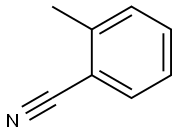| Identification | More | [Name]
o-Tolunitrile | [CAS]
529-19-1 | [Synonyms]
2-CYANOTOLUENE
2-METHYLBENZENECARBONITRILE
2-METHYLBENZONITRILE
2-TOLUNITRILE
CNT
LABOTEST-BB LT01273178
OCT
O-CYANO TOLUENE
O-METHYLBENZONITRILE
o-toluic nitrile
O-TOLUNITRILE
o-toluonitrile
O-TOLYL CYANIDE
o-Tolylnitrile
1-Methyl-2-cyanobenzene
2-methyl-benzonitril
2-Toluenkarbonitril
benzonitrile,2-methyl-
o-Methylcyanobenzene
ortho-Tolunitrile | [EINECS(EC#)]
208-451-7 | [Molecular Formula]
C8H7N | [MDL Number]
MFCD00001792 | [Molecular Weight]
117.15 | [MOL File]
529-19-1.mol |
| Chemical Properties | Back Directory | [Appearance]
clear colorless to slightly yellow liquid | [Melting point ]
-13 °C | [Boiling point ]
205 °C(lit.)
| [density ]
0.989 g/mL at 25 °C(lit.) | [refractive index ]
n20/D 1.5279(lit.)
| [Fp ]
184 °F
| [storage temp. ]
Store below +30°C. | [solubility ]
Chloroform (Slightly), Methanol (Slightly) | [form ]
Liquid | [color ]
Clear colorless to slightly yellow | [PH]
7 (H2O, 20℃) | [explosive limit]
1.1-6.7%(V) | [Water Solubility ]
<0.1 g/100 mL at 17 ºC | [Merck ]
14,9537 | [BRN ]
1857417 | [Dielectric constant]
18.5 | [Exposure limits]
NIOSH: IDLH 25 mg/m3 | [InChIKey]
NWPNXBQSRGKSJB-UHFFFAOYSA-N | [CAS DataBase Reference]
529-19-1(CAS DataBase Reference) | [NIST Chemistry Reference]
Benzonitrile, 2-methyl-(529-19-1) | [EPA Substance Registry System]
529-19-1(EPA Substance) |
| Safety Data | Back Directory | [Hazard Codes ]
Xi | [Risk Statements ]
R38:Irritating to the skin.
R52/53:Harmful to aquatic organisms, may cause long-term adverse effects in the aquatic environment .
R36/37/38:Irritating to eyes, respiratory system and skin . | [Safety Statements ]
S61:Avoid release to the environment. Refer to special instructions safety data sheet .
S37:Wear suitable gloves .
S36:Wear suitable protective clothing .
S26:In case of contact with eyes, rinse immediately with plenty of water and seek medical advice . | [RIDADR ]
3276 | [WGK Germany ]
2
| [RTECS ]
XV0600000
| [TSCA ]
Yes | [HS Code ]
29269095 |
| Hazard Information | Back Directory | [General Description]
Light blue clear liquid. | [Reactivity Profile]
Nitriles, such as O-TOLUNITRILE(529-19-1), may polymerize in the presence of metals and some metal compounds. They are incompatible with acids; mixing nitriles with strong oxidizing acids can lead to extremely violent reactions. Nitriles are generally incompatible with other oxidizing agents such as peroxides and epoxides. The combination of bases and nitriles can produce hydrogen cyanide. Nitriles are hydrolyzed in both aqueous acid and base to give carboxylic acids (or salts of carboxylic acids). These reactions generate heat. Peroxides convert nitriles to amides. Nitriles can react vigorously with reducing agents. Acetonitrile and propionitrile are soluble in water, but nitriles higher than propionitrile have low aqueous solubility. They are also insoluble in aqueous acids. | [Air & Water Reactions]
Insoluble in water. | [Fire Hazard]
This chemical is combustible. | [Chemical Properties]
clear colorless to slightly yellow liquid | [Uses]
o-Tolyl Cyanide, is a versatile intermediate, used in the synthesis of various pharmaceutical and biologically active compounds. It can be used in the preparation of highly efficient triarylene conjugated dyes for sensitized solar cells | [Synthesis Reference(s)]
The Journal of Organic Chemistry, 60, p. 2948, 1995 DOI: 10.1021/jo00114a060 | [Purification Methods]
Fractionally distil the nitrile, wash it with conc HCl or 50% H2SO4 at 60o until the smell of isonitrile has gone (this also removes any amines), then wash it with saturated NaHCO3 and dilute NaCl solutions, then dry it with K2CO3 and redistil it. [Beilstein 9 IV 1703.] |
|
|





